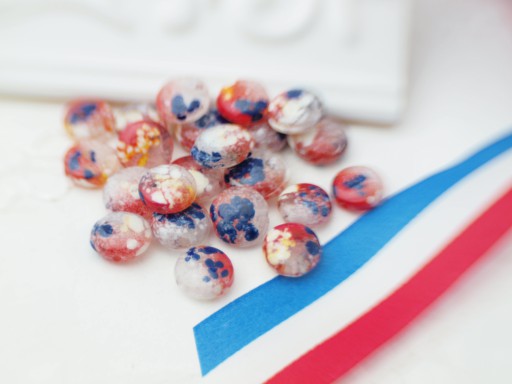So I had this big chunks of very dark opaque navy and ivory frit floating around, obviously strained out with a frit sorter I purchased some years ago. I don't typically like big chunks, because on a hollow bead, they tend to distort the wall thickness—but since I was pressing the beads, this wasn't as critical.
And since I had to make a bunch of red-white-blue beads for our guild challenge, and this stuff was lying around, I wondered what would happen....
I started by making a transparent bead, and rolled the top half in TE light red, and perhaps the top third in darker red (to give a bit of gradation and depth). Then I mashed the bead on one side into the ivory, and the other side into the very dark blue; then melted the frit enough in to stick, and rolled the middle to bottom part of the bead—ok, the whole bead, but I only heated the middle to bottom part—in fine opaque white 204 frit [which, sad to say, isn't very opaque at that size] and pressed. If the bead was too small for the press, I practised casing in clear and repressed.
I was making/wrapping various red-white-blue things for f2tY to take to Japan as omiyage, so I had the ribbon out; I added other white background props in keeping with the color them, and since these beads were kinda ugly, figured they'd benefit from the lensbaby treatment—a fair assessment, I'd say.
Made with smaller frit overall, a somewhat lighter navy and (ideally, a darker/candy apple red) Thompson Enamel, not to mention the more opaque TE white fine frit (as opposed to the effetre) they'd probably be pretty handsome. —But I have to say, that yellow tinge is kind of interesting. Transparent reds sometimes can be differentially struck to yellow and orange[1] so I presume some sort of reaction with the white is causing this.[2]
But I don't really know.
Unless otherwise noted, text, image and objects depicted therein copyright 1996--present sylvus tarn.
Sylvus Tarn